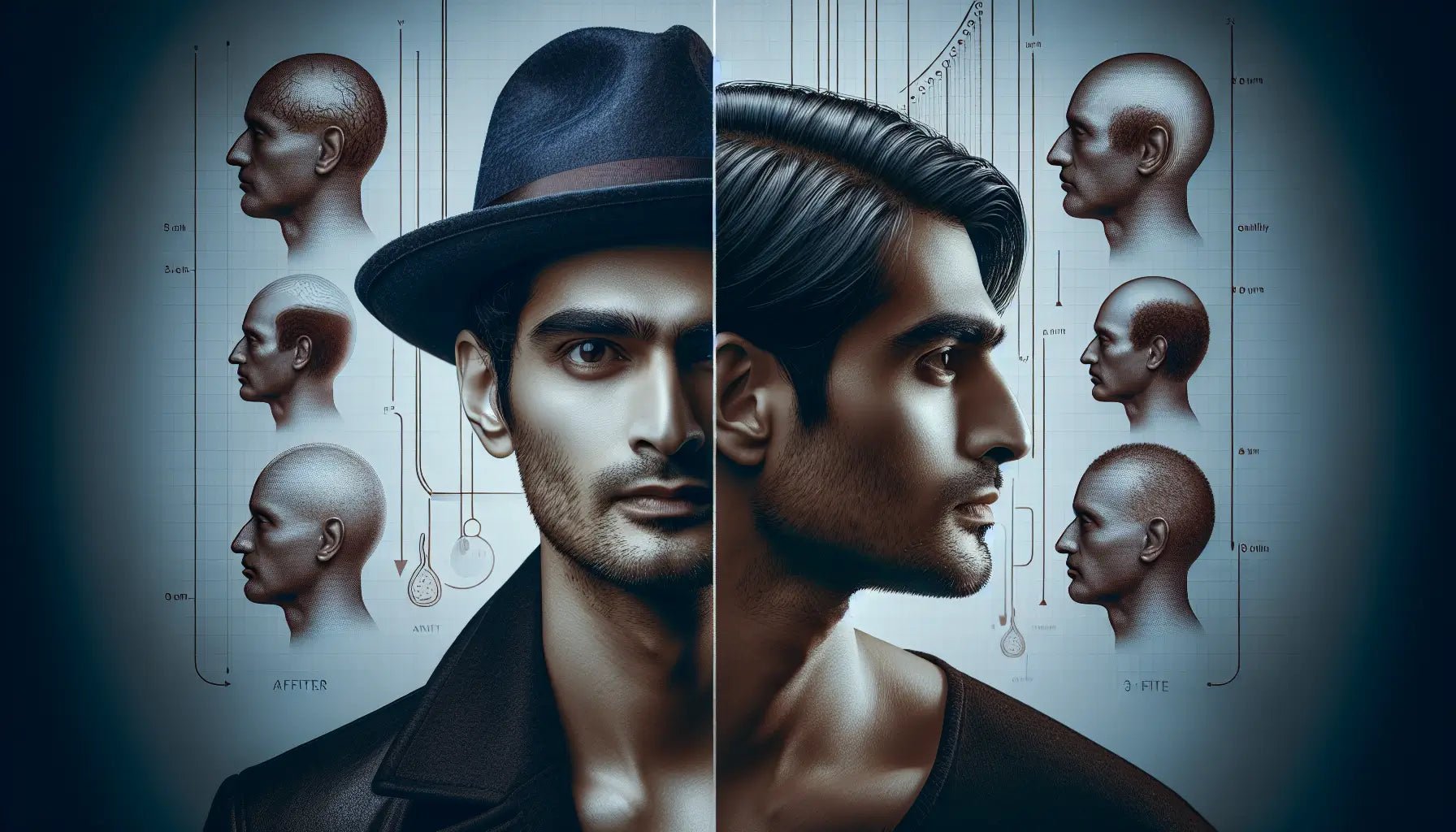Have you ever wondered if wearing a hat could make you lose your hair? It's a question that's crossed many minds, especially if you love sporting caps, beanies, or other headgear.
Does wearing a hat cause hair loss?
This concern has sparked debates and left many hat enthusiasts worried about their beloved accessories.
In this article, you'll discover the truth behind the hat and hair loss connexion. We'll explore the science of hair loss, debunk common myths, and look at how hats might affect your hair.
You'll also learn about best practises for hat wearers and get expert opinions on the matter. By the end, you'll have a clear understanding of whether your favourite hat is friend or foe to your locks.
The Science Behind Hair Loss
Common causes of hair loss
You might be surprised to learn that hair loss is a common problem affecting millions of people worldwide. While genetics plays a big role, other factors can contribute too. These include stress, hormonal changes, and certain medications.
The most common type of hair loss is called androgenetic alopecia, or pattern baldness. It's caused by a sensitivity to a hormone called DHT, which makes hair follicles shrink and eventually stop producing new hair. This type of hair loss runs in families, so if your parents or grandparents experienced it, you might too.
The hair growth cycle
Your hair goes through a cycle of growth and shedding. This cycle has four main stages:
- Anagen (growth): This is when your hair is actively growing. It can last 3-5 years or even longer.
- Catagen (transition): The hair stops growing and separates from its follicle. This lasts about 10 days.
- Telogen (rest): The hair doesn't grow but stays in place. This phase lasts about 3 months.
- Exogen (shedding): The old hair falls out, making room for new growth.
It's normal to lose 50-100 hairs a day during the shedding phase. If you're losing more than that, it might be a sign of a problem.
Genetic factors in hair loss
Your genes play a big part in whether you'll experience hair loss. In fact, up to 80% of pattern baldness cases are due to genetic factors. These genes affect things like:
- How sensitive your hair follicles are to DHT
- The structure and texture of your hair
- How quickly your hair grows
Men and women experience genetic hair loss differently. For men, it often starts with a receding hairline or thinning at the crown. Women usually see overall thinning across the scalp, but their hairline usually stays intact.
Remember, while you can't change your genes, there are ways to slow down hair loss and keep your hair healthy. Eating a balanced diet, managing stress, and using gentle hair care products can all help.
Rosemary Rice Water Moisturising Spray Can help you in Hair Growth.
Debunking the Hat-Hair Loss Myth
Scientific studies on hats and hair loss
You might be wondering if there's any truth to the idea that wearing a hat can make you go bald. Well, let's look at what science has to say.
The truth is, this topic hasn't been studied much. A couple of studies with identical twins found a link between wearing hats and more hair loss in men, but not in women.
Interestingly, another study showed that wearing hard hats or military headwear didn't affect hair loss at all.
Expert opinions on hat-wearing and baldness
So, what do the experts think?
Dr. John Anthony, a dermatologist, says it's a tricky question. He thinks that very tight or hot hats might reduce blood flow to your hair follicles. This could stress them out and make them fall out. At first, this hair loss would be temporary, but over time, it could become permanent.
Another expert suggests that if your hat fits right, it's unlikely to cause baldness. But if you're already losing hair, wearing a hat might speed up the process a bit. When you put on or take off a hat, it can pull out hairs that are already loose. This is especially true for snug hats like beanies.
Here's the good news: your hat would need to be super tight to cut off air and blood flow to your hair follicles. Even then, it probably wouldn't cause baldness on its own. It might just make existing hair loss a bit worse.
So, don't worry too much about your favourite hat. Just make sure it fits comfortably and isn't too tight. A loose-fitting hat like a fedora is probably a safer choice than a tight baseball cap or beanie.
Potential Hair Damage from Hats
While wearing a hat doesn't directly cause hair loss, it can lead to some hair damage if you're not careful. Let's look at a few ways your favourite cap might affect your hair.
Traction alopecia
If you wear hats that are too tight, you might run into a problem called traction alopecia. This happens when your hat pulls on your hair too much.
It's like when you wear your hair in tight braids or ponytails all the time. The constant pulling can make your hair break or even fall out.
To avoid this, make sure your hats fit comfortably and aren't squeezing your head.
Hygiene concerns
Hats can trap sweat and oil against your scalp. If you wear a hat for a long time without washing it, bacteria and dandruff can build up. This can make your scalp itchy and unhealthy. To keep your scalp happy, clean your hats regularly and give your head a break from hat-wearing now and then.
Impact on scalp health
Wearing a hat all the time can affect your scalp's health. It can block air from getting to your scalp, which might slow down hair growth. Some people might even be allergic to materials used in hats, causing scalp irritation.
If your scalp feels itchy and doesn't get better after a few days, it's a good idea to talk to a doctor.
Remember, it's okay to wear hats, but give your head some hat-free time too. Choose hats made of breathable materials and make sure they're not too tight. By taking these simple steps, you can enjoy your hats without worrying about your hair health.
Best Practises for Hat Wearers
Choosing the right hat
When picking a hat, think about what it's made of. Natural materials like cotton or wool are better for your hair than synthetic ones. They let your scalp breathe. If you're out in the sun a lot, go for a wide-brimmed hat. It'll protect your hair and face from harmful rays. For a comfy fit, choose hats that don't squeeze your head too tight. Loose-fitting hats are kinder to your hair and scalp.
Proper hat care
Keep your hats clean to keep your hair happy. Dirty hats can make your scalp itchy and unhealthy. Wash your hats regularly, especially if you wear them a lot. This stops bacteria and sweat from building up. If you've been swimming, rinse your hair right away. Chlorine can be harsh on your hair. Use a special swimmers' shampoo and deep conditioner afterwards.
Balancing hat-wearing with scalp health
Don't wear your hat all day, every day. Give your scalp some air now and then. If you wear hats a lot, you might notice more hair falling out when you take them off. Don't worry too much - this is usually just loose hair that was ready to fall anyway. But if you're concerned, try wearing your hat less often. Use a leave-in conditioner with zinc oxide to protect your hair when you're not wearing a hat. And remember, if your scalp feels itchy or sore, it might be time to see a doctor.
Conclusion
To wrap things up, wearing a hat doesn't directly cause hair loss, but it can affect your hair health if you're not careful.
The key is to choose hats that fit well and are made of breathable materials. It's also a good idea to give your scalp some air now and then by taking off your hat. Remember, genetics play a much bigger role in hair loss than your favourite cap does.
Taking care of your hair and scalp is important, whether you wear hats or not. Keep your hats clean, don't wear them too tight, and pay attention to how your scalp feels. If you're worried about losing hair, talk to a doctor.
They can help you figure out what's causing it and suggest ways to keep your hair healthy. In the end, you can enjoy wearing hats without stressing about going bald, as long as you're smart about it.
FAQs
1. Can wearing a hat lead to hair loss?
Contrary to popular belief, there is no evidence to suggest that wearing a hat causes hair loss or impedes hair growth. The notion that hats are responsible for hair loss is a misunderstanding of cause and effect.
2. Do hats impede scalp circulation?
It is a common misconception that hats suffocate the scalp, leading to reduced blood flow and potentially causing hair loss. However, this idea is not supported by scientific evidence.
3. What are some methods to reduce hair loss in men?
To combat male hair loss, several treatments are available:
- Minoxidil (Rogaine): This topical solution is applied directly to the scalp to stimulate hair follicles.
- Finasteride (Propecia, Proscar): This oral medication blocks the production of a potent form of testosterone associated with baldness.
- Dutasteride: Similar to finasteride, this drug may be more effective in some cases.
4. What is the primary cause of baldness in men?
The most prevalent cause of male baldness is Male Pattern Baldness, which is genetically inherited. Researchers believe a specific gene may influence the sensitivity of hair follicles to dihydrotestosterone (DHT), a hormone that causes the follicles to shrink. This shrinkage results in hair that is finer, thinner, and shorter when it regrows.




